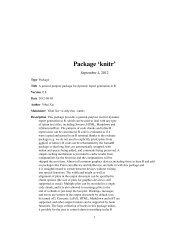Package 'openair'
Package 'openair'
Package 'openair'
You also want an ePaper? Increase the reach of your titles
YUMPU automatically turns print PDFs into web optimized ePapers that Google loves.
140 trendLeveldrop.unused.typesHide unused/empty type conditioning cases. Some conditioning options maygenerate empty cases for some data sets, e.g. a hour of the day when no measurementswere taken. Empty x and y cases generate ’holes’ in individual plots.However, empty type cases would produce blank panels if plotted. Therefore,the default, TRUE, excludes these empty panels from the plot. The alternativeFALSE plots all type panels.... Addition options are passed on to cutData for type handling and levelplot inlattice for finer control of the plot itself.DetailstrendLevel allows the use of third party summarising functions via the statistic option. Anyadditional function arguments not included within a function called using statistic should besupplied as a list of named parameters and sent using stat.args. For example, the encoded optionstatistic = "mean" is equivalent to statistic = mean, stat.args = list(na.rm = TRUE)or the R command mean(x, na.rm= TRUE). Many R functions and user‘s own code could be appliedin a similar fashion, subject to the following restrictions: the first argument sent to the functionmust be the data series to be analysed; the name ‘x’ cannot be used for any of the extra options suppliedin stat.args; and the function should return the required answer as a numeric or NA. Note:If the supplied function returns more than one answer, currently only the first of these is retainedand used by trendLevel. All other returned information will be ignored without warning. If thefunction terminates with an error when it is sent an empty data series, the option stat.safe.modeshould not be set to FALSE or trendLevel may fail. Note: The stat.safe.mode = TRUE optionreturns an NA without warning for empty data series.ValueAs well as generating the plot itself, trendLevel also returns an object of class “openair”. Theobject includes three main components: call, the command used to generate the plot; data, thedata frame of summarised information used to make the plot; and plot, the plot itself. If retained,e.g. using output
















